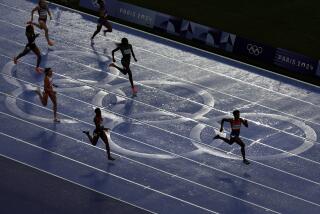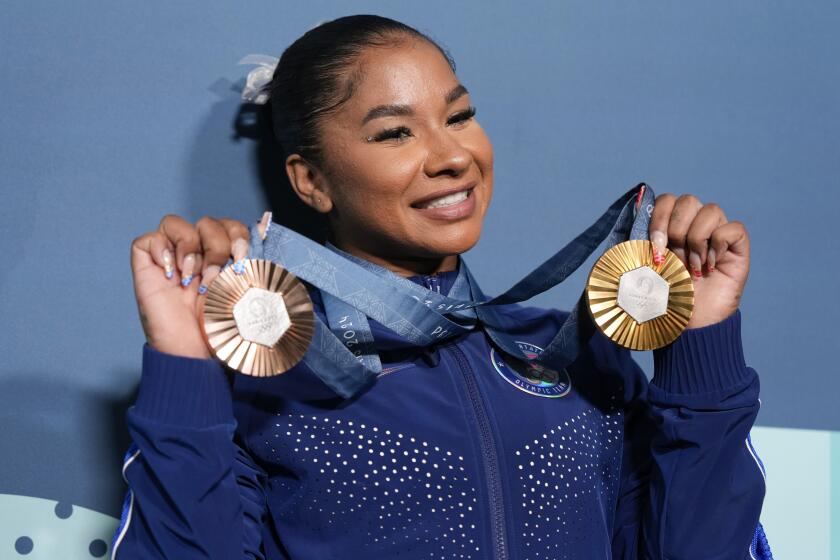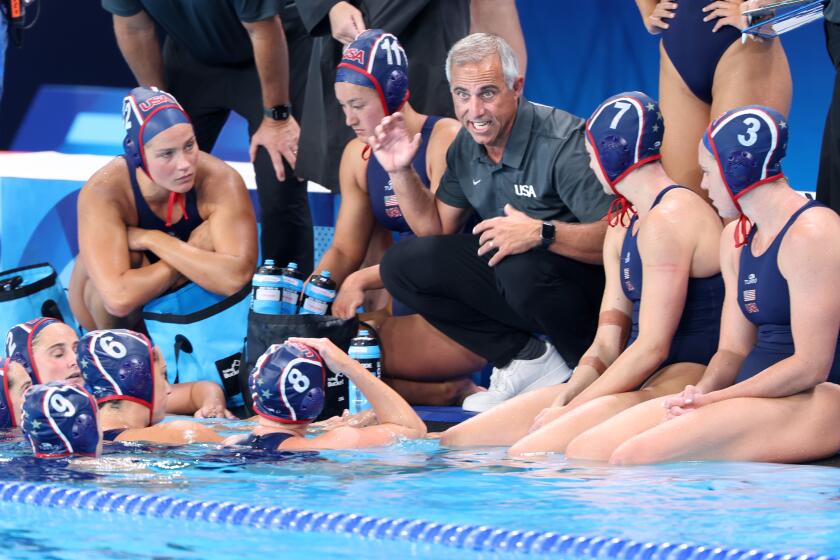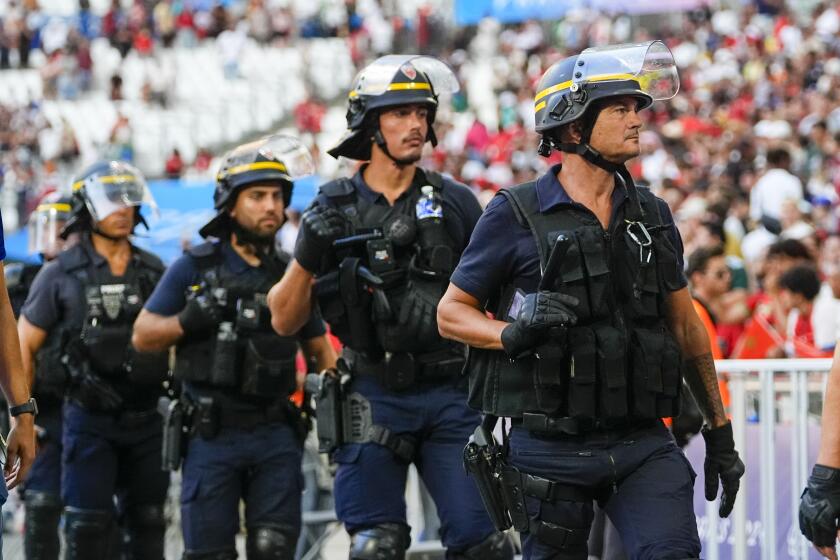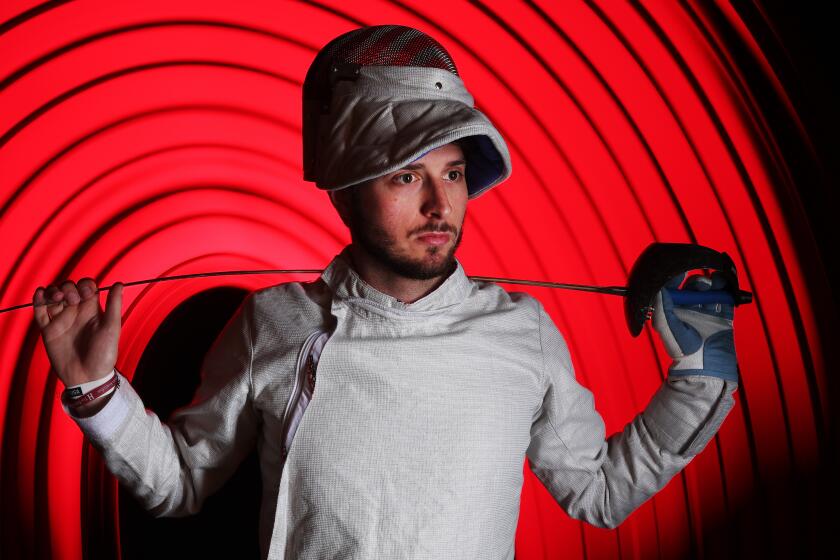Keeping Up With the Sprinting Surgeon
“Everybody needs an escape hatch from tension,” Robert Watanabe says. “I find my escape in the 100-yard dash.”
He sprints like a world-class runner at speeds of nearly 10 yards a second. His full-time occupation, however, is not athlete, nor is he at an age where world-class athletes are usually found. Watanabe, 59, is an orthopedic surgeon on the staff of St. John’s Hospital, Santa Monica.
Green smock flying, he dashes weekdays on a special track designed for the hospital’s cardiac patients. At other times he runs along San Vicente Boulevard and in regular weekend workouts at the UCLA track. He continues to match his college-era speeds of 36 years ago.
Believer in Fitness
Wiry and compact (5 feet 5 inches, 135 pounds), Watanabe keeps in training shape not only for its escape value and not only because he is a fervent believer in physical fitness; he enjoys competitive sports. Two years ago he won five gold medals in the Senior Olympics in Los Angeles. He sprinted again in Rome during last month’s VI World Veterans Games, a series of Olympian-caliber events for older athletes (including such former Olympic gold medalists as Parry O’Brien). Watanabe ran the 100-meter dash in 12.76 seconds, winning a bronze medal, and the 200-meter dash in 26.63 seconds.
“I don’t recommend sprinting for everyone,” said Watanabe, who devotes the major part of his practice to sports medicine and treats many seniors. “Slow, rhythmic running is a safer exercise for most people. A miler almost never pulls a muscle, while a sprinter in a 100-yard dash is required to run at maximum speed, and that has risks for anyone past 40.”
Bob Watanabe has been running at a fast clip most of his life. His quiet manner reflects the extraordinary control and discipline of one who has endured, coped with and conquered personal anguish.
The only son and eldest of five children in a Japanese-American family, he began sprinting during boyhood in San Luis Obispo. The happy life style of the prosperous, hard-working Watanabe family was shattered by Pearl Harbor. Along with thousands of other Japanese-Americans, Bob’s parents and sisters were herded into a detention camp in the Arizona desert.
It fell to Bob, then 15, to sell the family’s comfortable home, autos and other holdings, including his father’s wholesale grocery business and his mother’s restaurant. Faced with the threat of total loss, the internees had no chance to negotiate for fair prices; the Watanabes’ possessions were sold for less than 10 cents on the dollar.
Bob joined his parents and sisters in the detention camp. With 10,000 occupants on a strip of land one mile square, the camp was surrounded by barbed wire. Its living quarters consisted of Army-type barracks, with each structure divided into four rooms, and each family assigned to a single room. “I burned with bitter feelings,” Watanabe recalled in an interview. “At high school classes in the camp we were asked to write a paper on our experiences. I wrote a scathing denunciation of the entire approach to relocation and concentration camps.
“All I could feel was blind anger. I worked off my personal fury by sprinting, running here and there inside the camp. I was able to adapt because I was 15. Today, approaching my 60th birthday, the bitterness has faded from memory. But I also know I couldn’t make that kind of adjustment again.”
Moved to Detroit
After two years, restrictions were eased; internees were allowed to move away from the West. Watanabe went to Detroit, where he found a job inspecting artillery shells in a munitions factory. He also signed up at Wayne State University and, on the side, he kept running.
He felt a powerful desire to obtain an education, Watanabe said, an ambition traceable to “the discipline of my childhood training. Among the Japanese there is a built-in assumption that children will strive and succeed, stretch and learn. My parents expected me to go to college. Nothing interfered with that, not even the disruption of wartime internment. They made it clear to me that education is essential to success in any field.”
After a year at Wayne State, he enlisted in the Army. His fast feet found a place on the Army Olympic track team. Following a two-year hitch, an assist from the GI bill enabled him to enter UCLA, where he studied medicine and ran on the track team.
He followed a curious path to medicine, he said later. Even though others could understand his resentment over being an internee, Watanabe said, “I felt guilty about my lingering bitterness at the way we’d been treated. Then the guilt feelings turned into a real desire to help others. Medicine seemed the answer.”
For a time he devoted himself mainly to children’s orthopedics, but his personal involvement in sports led to an additional concern with athletes’ injuries, and he became one of four orthopedic surgeons working with UCLA’s football team. In recent years, as jogging, tennis and other weekend sports have gained popularity in the 40-and-over age bracket, with an accompanying rise in the incidence of physical injuries, Watanabe has gradually turned his attention to the problems of older athletes. He also teaches part-time at the UCLA Medical Center’s Trauma Clinic.
Watanabe’s considerable energy and wide range of interests have led him into multiple activities. A boyhood fascination with cameras sparked him to become a serious photographer with a fully equipped darkroom. He studied art at UCLA to broaden his understanding of light and shadow. He has also taken numerous courses in photography and he has worked with professionals to make special training films to illustrate kinds of treatment in orthopedic surgery. He has launched his own company to make technologically advanced medical instruments for orthopedic procedures.
One time he combined his interests in photography, teaching and medicine into a special project: an invitation from the American Academy of Orthopedic Surgeons and UCLA to help devise new teaching techniques in medicine.
“The rationale,” he said, “was that teaching methods change too slowly. A fixture of every classroom is the professor who stands at a blackboard, writing with one hand and erasing with the other, scribbling at full speed while the students race to keep up with him. They wind up with a collection of notes and fragmentary comprehension. They probably could have learned more, in less time, from a textbook.
‘Take a Tip From TV’
“Perhaps I’m prejudiced because of my interest in photography, but why has the teaching profession been so slow to make extensive use of modern media such as slides, movies and television? Why not take a tip from TV commercials, putting into a neat, attractive package a concise, clearly presented message with a beginning, middle and an end?
“I’ve heard many students complain that the typical medical lecturer is a man who inundates you with technical material without really explaining what the lecture is about.
“Traditionally, you see, medical schools have hired professors who are recognized for their achievements in research, but they’re hired without reference to their ability as teachers. My proposition is that students are changing, and the schools must change also.
“Realistically, I don’t believe the medical schools can reform those professors who have been teaching in certain structured ways for 20 or 30 years. What we must do now is alert the students to new and better methods, because they are the professors of the future. We must lead them into improved, more sophisticated techniques, urging them to discriminate between old and new methods.”
Not all of Watanabe’s photography deals with medicine. “I take pictures of anything that appeals to me,” he said. “Fortunately I approach photography as a hobby and I don’t have to make a living at it. I say ‘fortunately’ because a professional has to satisfy the requirements of editors. Taking pictures for my own pleasure, I can do as I please.
“For example, I’m dazzled by the challenge of underwater photography. Bogged down with scuba equipment--tank, goggles, mask--and carrying a camera encased in a water-tight shell, pressing against a force of water that pushes one’s body back and forth, a photographer tries for artistic shots and it’s almost a comic experience. Fish, as distinct from people, don’t cooperate. Instead of waiting for the photographer, fish just swim blithely away.”
Kinship With Wood
Watanabe is also an accomplished woodcarver, a weekend pursuit that has produced cabinets, bookcases and other furniture. “There’s a close connection between orthopedics and working in wood,” he said. “Put aside the obvious differences between human life and architecture, put aside the feelings and emotions of doctor and patient, think only of the technique involved, and you find a real kinship between orthopedics and carpentry. The orthopedist works with power drills and a wide range of instruments which are very similar to those used in cabinetry. To put together a fracture, or to perform a reconstructive operation on a leg, hip or arm, a surgeon needs a keen eye for proportion, not much different at the outset from the way a conscientious carpenter begins.”
Divorced and the father of two grown children, Watanabe lives in a cheerful apartment in Santa Monica. He arrives at St. John’s Hospital for surgery appointments most mornings by 7, and his afternoons are usually set aside for office hours. The days are made longer by a continuing proliferation of lawsuits arising from accidental injuries.
“Mostly they involve routine courtroom appearances,” Watanabe said, “but they cause real time problems. My office is usually crowded with patients in distress, waiting anxiously to be seen, and I’m concerned about their pain, concerned about talking to them and examining them, to find out what’s wrong and what needs to be done.
“Inevitably, in the midst of dealing with patients, there’s a call from a lawyer informing me that I’m to appear in court, but quickly. My testimony is required as an expert. Typically, it’s a workman’s compensation case involving an on-the-job injury. The patient had been sent to me earlier for an evaluation and a medical report, and now, if the person is unable to continue working, his lawyer summons me to court to testify.
“So I’m caught between a rock and a hard place. If I protest that I can’t go to court because my office is filled with patients in need of attention, the lawyer says: ‘OK, we’ll simply send the sheriff to bring you in.’ This experience isn’t peculiar to me. I’m sure every orthopedist faces the same difficult pressures.”
Watanabe deals with pressure, and at the same time keeps in physical shape, not only by sprinting but by other regular running activities. He often takes “a light workout” such as a combination of running and jogging at the rate of an eight-minute mile, from his Santa Monica apartment to St. John’s Hospital or back and forth to the ocean for a distance of five miles.
Interval Training
On weekends he does “harder” workouts--a series of dashes, ranging from 100 meters to 400 meters. He said: “This is very tough interval training where you might run rapidly for 200 meters, then walk 200 meters, which gives a two- or three-minute rest, then run rapidly another 200 meters, then walk. You might repeat this six times, and by then you can hardly get your breath. When I’m running really hard and pushing myself to do 400 meters, it’s at a speed fractionally faster than a four-minute mile. This isn’t easy. Some athletes say that 400 meters is probably the toughest race of all.”
Watanabe feels a special sympathy for “senior athletes who try to do too much, too soon, after too many years of only infrequent exercise, or perhaps of none at all. Often they’ll tear a shoulder muscle playing tennis, or strain the back, or damage the knee or foot while jogging.
“A moderate and gradual approach would be better, but it’s hard for me to criticize them, because they’re actually trying to do what’s best, they’re trying to improve, they’re trying to get away from the life style of the executive who smokes, drinks, pays no attention to diet or exercise, and dies off in his 40s or 50s.
“The best way to prevent a heart attack is to change your life style 10 years before it happens. Exercise is good not only for your cardiovascular system, not only for your heart and lungs, but for your total well-being. The worst thing, really, is inertia.”
Inertia has never been a problem for Bob Watanabe. “The big hurdle for me has always been tension,” he said, “and I’ve learned how to live with it. Whenever things get rough and pressure starts to build, I go out somewhere and sprint. That’s my escape hatch.”
More to Read
Go beyond the scoreboard
Get the latest on L.A.'s teams in the daily Sports Report newsletter.
You may occasionally receive promotional content from the Los Angeles Times.


